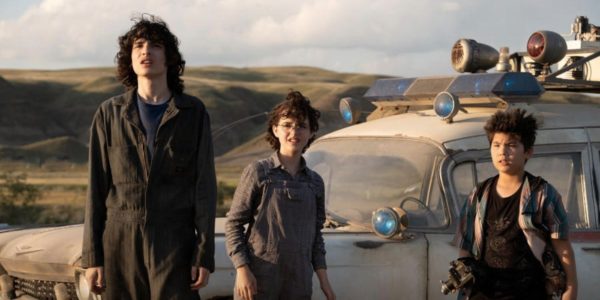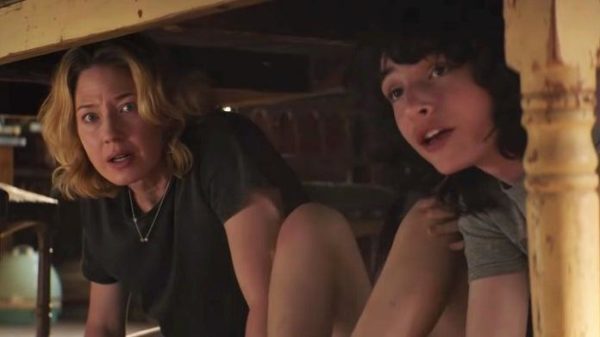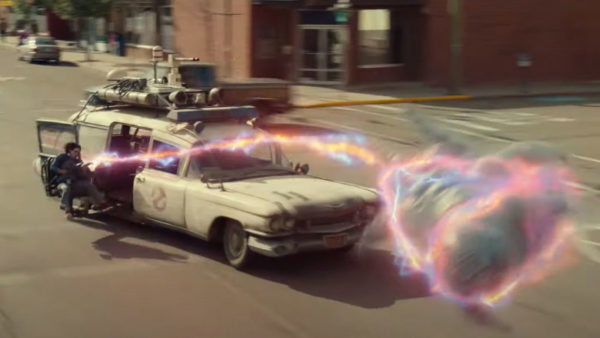
It’s nearly impossible to discuss the new Jason Reitman tentpole film Ghostbusters: Afterlife without acknowledging the elephant in the room.
Yes, the new film acts as a direct sequel to the two original Ghostbusters films.
And no, it doesn’t address Paul Feig’s 2016 female-driven reboot.
The new film’s reverence for the original films (in the form of pretty egregious fan service), plus Reitman’s nepotism in taking over the reins of the franchise, plus the full-on erasure of the previous film, is pretty much guaranteed to cause a (social media) stir.
Acknowledging that there is a ton of cultural baggage at play in the new film’s reception (targeted gender discrimination, toxic fanbase, etc), though, how does the film itself actually fare?
Honestly, it’s fine. It’s pretty solid genre fare that will appeal widely to families, franchise fans and teen boys alike; it features a likeable cast of recognizable faces; and it tells a relatively stand-alone story in its first half before dovetailing wildly into a nostalgia-fueled haze in the back half. For general audiences, it’s a perfectly serviceable and amusing night at the movies, though that might be damning it with faint praise considering the studio clearly sees the film as both a palette cleanser and an opportunity to reinvigorate a valuable brand.

The film follows cash-strapped single mother Callie (Carrie Coon, The Leftovers) and her two kids: girl-crazy Trevor (Finn Wolfhard, Stranger Things) and socially awkward genius Phoebe (McKenna Grace, Annabelle Comes Home). When the family is evicted by an unsympathetic landlord, they relocate to Summerville, Oklahoma to take possession of the farm house of Callie’s recently deceased father – clearly a former ghostbuster, but whose identity is foolishly kept secret for nearly half of the film (it’s not hard to figure out).
As Trevor connects with local girl Lucky Domingo (Celeste O’Connor) via a job at the roller skate diner, Phoebe befriends both her summer school teacher Chad Grooberson (Paul Rudd) and classmate Podcast (Logan Kim). Plans soon go awry when the three inadvertently open a dormant ghost trap and awaken a simmering malevolent presence in the nearby mountain. Amidst burgeoning relationships between Lucky & Trevor and Chad & Callie, as well as shopping trips to Walmart, a doomsday event with ties to the first film emerges that could devour the world.
It is this last element that will prove highly divisive; particularly in the back half of the film when it feels as though Afterlife is propped up entirely by nostalgia and sentimentality. Whole lines of dialogue, as well as action sequences, are lifted wholesale from the ’84 film, and, yes, there are the usual compulsory cameos by Dan Akroyd, Ernie Hudson, Bill Murray and Sigourney Weaver, as well as Stay Puff Marshmallow Men (now in cute, marketable, toy-friendly size!).

Let’s be clear: acting as if any of this is new and appalling is disingenuous. This is familiar territory for $150M blockbusters, and many of the set-pieces do manage to strike a balance between fun and sentimentality. An early action scene, for example, finds the kids (the actual protagonists of the film) taking ECTO1 for a joyride around town to capture a centipede-version of Slimer as it wreaks havoc. It’s familiar, sure, but that doesn’t mean it isn’t also enjoyable.
Depending on your penchant for on-the-nose, cutesy humour, Podcast is either a great new character or one of the most grating recent incarnations of the “lovable annoying kid” trope. Coon, meanwhile, is wasted in a role that could have been played by any actress that Hollywood has deemed “momable” while Rudd is his usual lovable self, although it should be noted that neither adult is given anything to do (the film really isn’t about the adults).
That leaves Wolfhard and Grace the responsibility of leading the film and the pair prove more than up for the task. The two young actors are equally adept at handling the wonder of inheriting ghostbusting equipment as they are at being cynical about spending a summer in a dusty Oklahoma town.
The coming out of age narrative for each – Phoebe making social connections, Trevor engaging in a chaste teen romance – don’t break any new ground, but that’s hardly the point. The reality is that the intended audience for this film doesn’t care about these new characters anyways: they’re just waiting for Venkman, Ray and Winston to show up and cross the streams.
The Bottom Line: Audiences who can set aside their issues with the studio’s mishandling of the 2016 text and prepare themselves for high levels of familiarity and nostalgia will find plenty to enjoy in Ghostbusters: Afterlife. It’s a solid, albeit forgettable blockbuster that appeals primarily to fans of the original 1984 film.
Ghostbusters: Afterlife is in theatres Nov 19, 2021